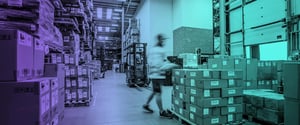
Hybrid fulfilment as a strategy to future-proofing your brand
Ecommerce isn’t what it used to be. You’ve grown into a bustling brand managing more SKUs, more sales channels, seasonal spikes, influencer campaigns, and expanding markets. But if you’re still relying on one warehouse, one fulfilment method, and one way of thinking about operations, you’re probably starting to see the cracks.
Fulfilment has quietly moved from a background function to a strategic growth lever. It’s no longer just about getting boxes out the door. It’s the competitive advantage and the fuel for your brand’s growth engine. It’s about delivering on your customer promise at scale. And if you want to keep up, you need to get familiar with hybrid fulfilment.
In this article
- What is hybrid fulfilment, and why now?
- Why a single fulfilment model could be holding you back
- What a hybrid fulfilment strategy looks like in practice
- How to approach your own hybrid model
- The role of technology and visibility in making it work
- How to choose the right hybrid fulfilment partner
- Future-proofing your brand with hybrid fulfilment
What is hybrid fulfilment, and why now?
Hybrid fulfilment is a blended approach to logistics, mixing in-house operations with outsourced 3PLs, and sometimes even drop shipping. It’s not a trend; it’s a response to what modern ecommerce demands: adaptability.
Think of it as building a fulfilment strategy that plays to your strengths while supporting scale. You might manage complex, branded packaging in-house, while a trusted partner handles international orders, subscriptions, or high-volume SKUs from their fulfilment centres.
Ecommerce brands are favouring hybrid fulfilment because it gives them space to focus on what they do best, rather than doing everything. A hybrid, flexible approach results in the right things, in the right places, at the right time.
Why a single fulfilment model could be holding you back
Sticking to just one fulfilment model might have worked when you were shipping a few hundred orders a week, mostly to one market, with a relatively simple product range. Back then, consistency was manageable, and costs were predictable.
But things change fast. As your brand scales, so do the demands. New product lines. New territories. New customer expectations. And suddenly, that manageable, single-track fulfilment setup starts to strain under the weight.

In-house fulfilment only?
You’re in full control until growth kicks in. Suddenly you’re dealing with storage shortages, warehouse staff scrambling to keep up, and higher fixed costs with every new SKU or peak campaign.
You start turning down opportunities because your operations can’t flex. And while you’re hiring, training, and chasing packing benches, competitors are launching into new markets ahead of you.
Fully outsourced 3PL fulfilment?
You get scale, but depending on the fulfilment partner, you might lose grip on what makes your brand special; that unboxing experience, the handwritten note, the curated bundle.
When fulfilment is handled by someone who doesn’t understand your brand nuance, the customer experience suffers. And if something goes wrong? You’re often at the mercy of ticketing systems and SLAs instead of proactive, hands-on support.
Drop ship reliant?
Drop shipping can be useful, though it’s a risky foundation to build on. Lead times are longer, stock levels can be unreliable, and you lose control over the end-to-end experience. If the packaging isn’t right, or orders arrive late (or worse, don’t arrive at all), it’s your brand that takes the hit, not your supplier.
.webp?width=795&height=455&name=IFG-Full-Width-Quote-Template-5-1%20(2).webp)
Rigid operations don’t keep up with agile businesses. When you’re planning campaigns, flash sales, seasonal product drops, or global expansion, your fulfilment operations need to bend without breaking. And when something unexpected hits (like a carrier strike or viral TikTok moment), flexibility is the difference between riding the wave or drowning in orders.
A single fulfilment model might offer short-term clarity. But long-term, it’s the bottleneck that slows everything down.
What a hybrid fulfilment strategy looks like in practice
Hybrid fulfilment gives you options. That’s where its real strength lies. It’s not about doing everything yourself or outsourcing everything, rather making strategic choices based on what creates the most value for your business and your customers.
While every brand’s setup will be different, successful hybrid fulfilment strategies often align fulfilment methods with SKU profiles, customer expectations, and operational complexity.
By SKU type
- In-house. For some brands, especially those with in-house production or uniquely high-touch experiences, it may make sense to keep fulfilment of a limited number of high-value or customised SKUs. But unless fulfilment is a true internal strength, most ecommerce brands benefit from outsourcing the majority of their volume.
- 3PL. Fast-moving, high-volume SKUs are ideally suited to 3PLs. A strong partner can handle these with consistency and efficiency, freeing up your internal teams and infrastructure.
- Drop shipping. For made-to-order, oversized, or low-volume SKUs, drop shipping can keep operations lean without impacting customer satisfaction.
By geography
- Domestic fulfilment. You may choose to keep fulfilment closer to home where you want to control the customer experience or delivery speed.
- International fulfilment. Global 3PLs can help reduce shipping times and costs while navigating local compliance and customer expectations, with localised hubs from country-specific fulfilment centres.
By fulfilment complexity
- Brand-first orders, influencer kits, or subscription box campaigns. If your team has the capability, these can be managed in-house. But they’re often better handled by a 3PL experienced in custom kitting and packaging.
- Regulated products, FIFO processes, batch tracking, reconditioning, or temperature control. These require specialised infrastructure and are best handled by experienced 3PLs.
The goal is to allocate effort and resources where they create the most value, outsourcing complexity and volume, while retaining control of what defines your brand.
How to approach your own hybrid model
To build a hybrid strategy that supports your growth, start with structured evaluation. As with any new strategy, start by asking the right questions.
- Which parts of fulfilment do we need full control over, and why?
- Where does scale matter most and are we able to meet it internally?
- Which SKUs or order types have special handling requirements?
- Do our current tools support multiple fulfilment methods and partners?
- What service levels do our customers expect across different channels and geographies?
Alongside asking these questions, you’ll want to conduct a fulfilment audit.
- Map your current workflows.
- Identify recurring pain points (capacity bottlenecks, delayed shipping, errors, or cost spikes).
- Evaluate performance by SKU, channel, and region.
As part of the audit, score opportunities for improvement. Use a scoring model to prioritise what to insource, outsource, or streamline.
- Impact on customer experience: High / Medium / Low
- Operational complexity: High / Medium / Low
- Scalability potential: High / Medium / Low
- Strategic importance: Core / Supporting / Non-essential
For most ecommerce brands, it makes sense to focus on offloading what’s high in complexity but low in strategic value. Double down on what drives long-term brand equity and customer loyalty.
Hybrid fulfilment isn’t about doing more, but doing what matters, better. The goal isn’t to create complexity. It’s to create optionality.
The role of technology and visibility in making it work
Hybrid fulfilment doesn’t mean disconnected systems. The real power comes when your fulfilment network behaves like one unified operation, backed by integrated tech. Without it, hybrid fulfilment becomes chaotic. With it, you gain a powerful, adaptive fulfilment engine.
At IFGlobal, we use BladePRO, our proprietary fulfilment software, to bring visibility and control across all locations, whether in-house or outsourced.
- Real-time inventory updates across all warehouses
- Smart routing rules based on location, cost, or order profile
- Batch tracking and expiry control for regulated products
- Central reporting dashboards for your operations, finance, and customer experience teams
Our proprietary fulfilment system acts as the golden thread across the entire fulfilment network, whether inventory is spread across multiple fulfilment centres or partly managed in-house. Ultimately, it helps brands maintain operational consistency and data accuracy across all channels and geographies.
By combining a hybrid fulfilment model with technology like BladePRO, you create the backbone to your growth ambitions and a future-proof setup.
How to choose the right hybrid fulfilment partner
This isn’t a plug-and-play relationship. Choosing the right hybrid fulfilment partner comes down to finding a strategic collaborator who can scale with your brand.
More than just cost or warehouse space, they need to share your ambition, have the technical compatibility and the ability to flex as your needs evolve.
- Proven experience in hybrid fulfilment. Not every 3PL partner is built to support hybrid fulfilment models. Can they coordinate across multiple nodes - your in-house team, other partners, or even drop ship suppliers - and still deliver a consistent experience?
- Geographic reach and local expertise. Beyond warehouse locations, do they understand the nuances of your target markets? Customs, carriers, regulations, and last-mile performance can make or break delivery outcomes.
- Customisation capabilities. Can they deliver on the brand experience you’ve promised customers? Think branded packaging, inserts, kitting, or niche compliance requirements.
- Technology integration. Will their systems play nicely with yours? Look for real-time visibility, inventory management and order syncing, demand forecasting, and actionable reporting; especially if you're working across platforms.
- Operational flexibility. Will they support seasonal spikes, product launches, or SKU variety without friction? Your partner should adapt as fast as your marketing.
- Partnership mindset. Are they proactive and thinking with you, or just processing orders for you? A strong hybrid fulfilment partner brings ideas to the table. They solve challenges, spot opportunities, and help you scale smarter.
At IFGlobal, we’re built for hybrid fulfilment. Whether you're running a high-growth DTC brand or scaling internationally, we provide the infrastructure, strategic support, and BladePRO technology to help you balance control, cost, and customer experience.

Future-proofing your brand with hybrid fulfilment
The most resilient ecommerce brands don’t survive change; they’re built for it. Hybrid fulfilment gives you the tools to adapt faster, scale smarter, and serve customers better.
Instead of reacting to bottlenecks, you’re designing systems that flex with demand. Instead of being stuck in a rigid model, you’re choosing how and where every order is fulfilled. If your fulfilment setup isn’t evolving with your brand, it’s time for a rethink.
Exploring hybrid fulfilment?
If you're rethinking your current setup or starting to scale internationally, we're here to help. Let’s map out a model that works for your brand, now and as you grow.
Frequently asked questions
Hybrid fulfilment is a flexible, scalable logistics model that blends in-house fulfilment, outsourced 3PLs, and drop shipping. It empowers brands to align fulfilment with business goals – keeping control while outsourcing where it creates efficiency. In today’s fast-moving ecommerce landscape, it’s how ambitious brands stay competitive and grow sustainably.
If you’re battling spreadsheets, stockouts, delays, high operational costs, or missed market opportunities, your current model may be the bottleneck. A rigid model can’t support growing SKU counts, omnichannel sales, or cross-border ambitions. A hybrid fulfilment strategy gives you the agility to overcome these roadblocks. Design your fulfilment strategy with one of our experts today.
Absolutely. Hybrid fulfilment with IFGlobal means you retain creative and operational control over the brand moments that matter most. From custom packaging and personalised inserts to kitting, bundling, reworks, and reconditioning, our built-in value-added services ensure your customer experience stays consistent and on-brand, even at scale.
A hybrid setup flexes around your business. It could mean keeping high-touch orders in-house, while outsourcing fast-moving SKUs or international deliveries to a trusted 3PL like IFGlobal. It’s about strategic allocation - placing the right products, in the right locations, with the right fulfilment method. Let us help you with your strategy.
We don’t just store and ship. IFGlobal combines strategic guidance, global infrastructure, and our proprietary fulfilment software, BladePRO, to create seamless hybrid networks. From onboarding and workflow design to value-added services and ongoing support, we help you build fulfilment around your growth – not the other way around.
It starts with a strategic conversation. We’ll assess your current operations, uncover areas for improvement, and identify the fastest path to a more flexible, future-proof setup. From there, we’ll tailor a fulfilment model – supported by BladePRO and our global network – that meets your brand’s specific growth goals.

Phoebe is Communications and Events Manager at IFGlobal, where she brings the brand to life through strategic storytelling, partner communications, and standout events. With a background in B2B marketing, Phoebe helps make sure that every message, campaign, and moment reflects our ambition and energy.
When she’s not planning content or coordinating events, you’ll likely find Phoebe sea-swimming on her local beach, searching for her next travel destination, or heading off to a kick-boxing class.

